Ryan Hall's Blog, page 201
November 9, 2016
The Story Behind Michael Versteeg’s Record 830-Mile Arizona Trail Run
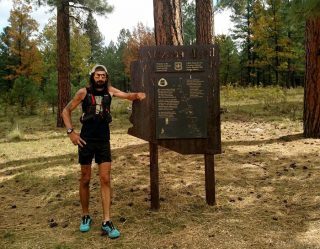
Michael Versteeg averaged 51 miles per day while running the length of the Arizona Trail in October. Photo: Jamil Coury
Michael Versteeg was aware of the 800-plus miles he’d have to run, the mountains he’d have to climb and the lonely stretches of wilderness ahead.
As he set out on Oct. 3 in his quest to set a speed record on the Arizona Trail, Versteeg had taken stock of all the obstacles. The Arizona Trail is a beautiful but brutal north-south path from the state line bordering Utah to the Mexican border over forest plateaus, rugged ranges and vast deserts. Versteeg would have to cross the Grand Canyon, deal with radical elevation changes (from 1,700 to 9,000 feet) and cope with the wild cards of weather and injuries.
“The Arizona Trail throws everything at you,” says Versteeg, 31, a carpenter and ultrarunner from Prescott, Ariz.
One feature he didn’t count on, though, were the grasslands of southern Arizona. He says running the trail’s final 200 miles were like running a painful gauntlet through vegetation exploding from late-summer monsoons. By the time Versteeg arrived, the plants were full of stickers, thorns and seeds. They penetrated his shoes and socks, shredded his feet and legs and almost brought him to his knees.
“These thorns would just go straight through my shoes, completely through my shoes, and so I’d go like 15 minutes and there would be so much pain I’d have to stop and rip everything out of my feet and toes,” he says.
Eventually he wrapped duct tape around his shoes and legs for protection.
RELATED: Jim Walmsley Crushes the Grand Canyon R2R2R Trail Running Record
At 4:41 a.m. on Oct. 19 he reached the border marker with Mexico, completing the trail in a record 15 days, 22 hours and 39 minutes. It surpassed the previous fastest known time (FKT) of 21 days, 14 hours and 16 minutes set by Adam Bradley in 2011. He logged 830 miles (thanks to a couple of wrong turns) and averaged just over 51 miles per day.
(Editor’s note: While Versteeg was setting a fastest known time on the Arizona Trail, Heather “Anish” Anderson was completing the trail in 19 days, 17 hours and 9 minutes, a record for a self-supported hiker. She also went north to south. She began on Oct. 7 and finished Oct. 27. Anderson, of Bellingham, Wash., also has previously set self-supported records on the Pacific Crest and Appalachian trails.)
Versteeg, who grew up in Arizona, had long wanted to complete the trail, even before he started running four years ago. The past two years he’s thought about going for the record. This year, he decided the time was right.
Now that it’s over, he’s grateful for seeing areas of the state he’d never seen and discovering a talent for multi-day, long-distance runs he didn’t know he had. He’s won a 100-mile race and other events at distances such as 50K, 88K and 60K, but says the Arizona Trail run was different.
“I can’t even wrap my head around what I went through for the past 16 days, and the difficulty of the terrain and trail and the weeds and things that made my feet fall apart at the end,” he says. “When I was finished, I was happy to be done.”
He takes more pride in this project than any previous run, especially after pushing through the last five days. “I found out a lot of things about myself,” he says.
Jamil Coury, an ultrarunner and race organizer from Phoenix who ran with Versteeg on three trail sections, says he has a right to be proud.
“Oh my God it was incredibly difficult,” says Coury, who knows the trail well after thru-hiking it in 31 days in 2008. “Fifty miles a day is what he was doing. Toward the end he was up to like 20 hours a day or more (on the trail), constantly out there. That accumulated mileage and stress on the body is pretty incredible.”
RELATED: Test Yourself on an Unsupported Trail Running Adventure
“Just keep moving”
The first section of the Arizona Trail was dedicated in 1988. Gradually, it evolved to its full length. It was designated a National Scenic Trail in 2009 and completed in 2011. Matthew Nelson, executive director of the Arizona Trail Association, says about 200 people—hikers, runners and mountain bikers—attempt to go start-to-finish annually. Several people have tried to break Bradley’s record in recent years, but none has come close, Nelson says.
As Versteeg prepared to run it, he didn’t do specific training. He had a full summer of racing in Alaska—where he was working for the summer—and, in the weeks leading up to his trek, he did what he calls “easy runs” before and after full days of carpentry work.
“So, I was getting used to long days, like 16-hour days of constantly being on my feet,” he says.
He already had a huge fitness base. He’s a longtime hiker, climber and outdoorsman who found a natural transition into ultras. He’s raced and trained continuously the past four years. At 6-foot-1 and 140 pounds—with a dark, bushy beard and long hair—he’s a lean machine built for trails. Plus, he knew this was no 50- or 100-mile run.
“You’re never really going that fast,” he says, noting he averaged just 3 to 4 mph. “So it’s 15- to 20-minute miles. You’re kind of jogging the easy stuff and power hiking everything else. You just have to keep moving for very long days.”
He had a rotating crew of 15-plus friends who gave him their time (and dipped into their own wallets) to supply him with food, water, clothes and equipment at designated locations. It wasn’t completely efficient, though, because some trail sections are so remote, vehicles can’t reach them. There were times he had to do 30 to 40 miles on his own.
The first 300 miles in the north were the easiest for him (excluding the climb out of the Grand Canyon). He ran on well-groomed trails through plateaus and forests. In his first six days he covered 340 miles—almost 57 per day.
Then came the less-manicured route through the remote areas of the Mazatzal mountains, Four Peaks Wilderness and Superstitions where his progress slowed. Fallen trees and overgrown bushes and branches clog the route, and it’s easy to get off track. Sometimes, only rock cairns mark the route.
“It’s bushwhacking and it’s very difficult country to move through,” says Versteeg, who says he could, at times, make just a mile an hour. By Day 10, his average was down to 50 miles per day.
Then came the grasslands, when he wished he’d been wearing boots rather than running shoes. The constant cuts and punctures caused swelling in his legs and feet. When he covered his shoes in duct tape, it shut off air flow, creating a wet environment that caused his feet to “fall apart.”
The going also became so slow he was getting little sleep. To keep to his 50-mile average—what he needed to do hit his goal of 16 days—he was on the trail 20 to 22 hours per day, taking naps at dawn and dusk.
“Even in the grass, he would be frustrated and uncomfortable, but he was always looking to get back on the trail,” says longtime friend Paco Cantu of Tucson, who crewed for Versteeg during the last five days. “He never for a second talked about quitting, never for a second was out of spirits.”
Finally, Versteeg completed the final few miles through the Coronado National Memorial, running by the light of his headlamp with Coury and Cantu past U.S. Border Patrol vehicles to the end. Versteeg wanted to see the finish spot in daylight, so he, Coury, Cantu and other crew settled in for a short nap until sunrise, when they celebrated by devouring burritos Cantu brought.
Over the next 24 hours, Versteeg says he slept 19. He felt tired for several days. Yet he had no significant injuries.
“Doing something like this the whole idea is sustainability and the ability to do it day in and day out,” he says. “So theoretically at the end of 16 days I could have kept going.”
Versteeg did the run for its challenge and also to raise awareness and money (through his GoFundMe page) for the Save the Confluence campaign to stop a proposed development project at the confluence of the Colorado and Lower Colorado rivers.
Now he says he finds himself poking around the Internet to see what the fastest known times are on other long trails. He wants to do another endurance trek—perhaps the nearly 500-mile Colorado Trail—but will take his time to decide. This trip told him he’s built for these.
Versteeg adds,“I’m pretty good at this multi-day thing because of my mental ability to just commit and be incredibly, unwaveringly stubborn.”
RELATED: A Runner’s Guide to Conquering the Grand Canyon
VIDEO: Chasing Jim Walmsley on his Record-Breaking Grand Canyon Run
The post The Story Behind Michael Versteeg’s Record 830-Mile Arizona Trail Run appeared first on Competitor.com.
Adidas Makes Running Shoes from Recycled Ocean Plastic
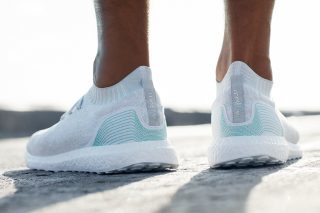
Each pair of the UltraBOOST Uncaged Parley shoes uses the equivalent of 11 recycled plastic bottles. Photo: Courtesy of adidas
A lot of running shoe brands have turned to more environmentally friendly materials and manufacturing processes in recent years, but adidas is about to unveil a new model with an even more unique “green” backstory.
Within the next week, adidas will unleash its new UltraBOOST Uncaged Parley running shoes, the first mass-produced footwear created using recycled plastic recovered from the ocean. The shoe features a Primeknit upper made from a mix of Ocean Plastic, a material created from plastic waste retrieved by Parley coastal interception and clean-up operations in the Maldives (95 percent) and recycled polyester (5 percent).
Each pair reuses the equivalent of 11 plastic bottles. The shoe laces, heel cap base material, heel webbing, heel lining and the sockliner cover are also made with recycled materials. Its design is inspired by ocean waves, to reflect the shoe’s unique story and adidas and Parley’s commitment to end the cycle of pollution in the oceans.
UltraBoost Uncaged Parley shoes ($200) will be available for purchase at adidas.com and select adidas retail shops, but only 7,000 pairs have been produced.
“Nobody can save the oceans alone. Each of us can play a role in the solution. It’s in the hands of the creative industries to reinvent faulty materials, products, and business models. The consumer can boost the demand for change. But it’s up to eco innovation leaders, like adidas, to make change a reality,” says Cyrill Gutsch, Founder, Parley for the Oceans. “With this shoe we demonstrate what’s possible. It’s even more than a shoe. It’s a flag, an invitation to join our movement.”
UltraBOOST Uncaged Parley is created using new technologies specifically engineered to up-cycle marine plastic debris into technical yarn fibers. The specially-developed Primeknit upper is combined with UltraBOOST’s signature elements to deliver an innovative running shoe that requires no compromise on performance.
One June 7, adidas celebrated World Oceans Day by releasing the first-ever edition running shoe—the adidas x Parley—in partnership with Parley for the Oceans. With a limited run of only 50 pairs available worldwide, Instagram users were given the chance to win a piece of sportswear history by raising awareness of the cause and uploading a video to show how they implement Parley A.I.R. and pledge to avoid single-use plastic.
The post Adidas Makes Running Shoes from Recycled Ocean Plastic appeared first on Competitor.com.
A Record 51,338 Runners Finished the 2016 New York City Marathon
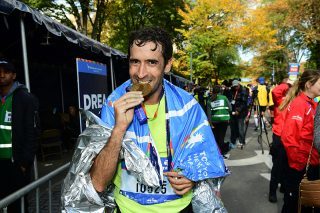
Raul Gonzalez Blanco, a Spanish soccer star, finished the 2016 New York City Marathon in 3:26:05. Photo: Courtesy New York Road Runners
There were a record 51,388 finishers at the 2016 New York City Marathon on Sunday, Nov. 6, making it the largest marathon in the world in history, announced today by New York Road Runners. The previous mark for the world’s largest marathon was the 2014 New York City Marathon with 50,530 finishers.
Below are some highlights and statistical information from the 2016 race, and here’s how to sign up for the 2017 race.
The Field
Note: All finisher numbers and results are unofficial pending race results review. Final official results will be released later this month.
51,995 starters
51,388 finishers
29,931 male finishers
21,457 female finishers
124 countries represented
50 states and the District of Columbia represented
Oldest male runner: Richard Gonzalez , 84, Louisiana, 7:18:47 (second year as oldest male finisher)
Oldest female runner: Bertha McGruder , 88, New York, 7:30:15
RELATED: Top 20 Finishers at the 2016 NYC Marathon
Winners
Male open race winner: Ghirmay Ghebreslassie 20, ERI, 2:07:51
At 20 years, 358 days, was the youngest male runner to have ever won the New York City Marathon
Winning time was fastest marathon on American soil in 2016
Female open race winner: Mary Keitany , 34, KEN, 2:24:26
Third consecutive victory; first to win three straight titles since Grete Waitz won five straight from 1982-1986
10th New York City Marathon victory for a Kenyan woman
Male wheelchair race winner: Marcel Hug , 30, SUI, 1:35:49
Won the race by sixth hundredths of a second over Australia’s Kurt Fearnley
Was his sixth consecutive win in an Abbott World Marathon Majors scored race, which is unprecedented for a male wheelchair athlete
Female wheelchair race winner: Tatyana McFadden , 27, USA, 1:47:43
Fourth consecutive and fifth overall New York City Marathon victory; now tied with Edith Hunkeler and Kurt Fearnley for most wins by a wheelchair athlete
Has now won Boston, London, Chicago and New York City Marathons each of the last four years
First American male finisher: Abdi Abdirahman , 39, Tucson, AZ, 2:11:23 (Third)
Highest finish by an American man since Meb Keflezighi won the race in 2009
Five American men finished in the top 10, the most since 2009
His time was the fourth best marathon performance by an American man in 2016
First American female finisher: Molly Huddle , 32, Providence, RI, 2:28:13 (Third)
Highest finish by an American woman since Shalane Flanagan was second in 2010
Her time was the third best marathon performance by an American woman in 2016
Winners of the NYRR Youth Invitational at the TCS New York City Marathon (1.8-miles):
Darius Gordan , 17, Bronx, NY, 10:17
Rainn Shepard , 10, New York, NY, 11:05
RELATED: Olympic Tri Champ Gwen Jorgensen 14th at 2016 NYC Marathon
Celebrities and Notable Personalities
Sean Astin , 6:02:33: Actor who is best known for his roles in “The Goonies,” “Rudy,” and the “Lord of the Rings” trilogy
Marion Bartoli , 5:40:04: 2013 Wimbledon Singles Champion and former top-ten player who ran in support of NYRR’s Team for Kids charity, raising over $5,000 for NYRR’s free youth running programs
Cynthia Erivo , 3:57:07: 2016 Tony Award winner for Best Actress in a Musical for The Color Purple; she also sang the national anthem at the start line
Raúl González Blanco , 3:26:05: Spanish soccer legend who played for Real Madrid
Jax , 5:17:37: American Idol finalist who ran her first marathon after overcoming thyroid cancer and raised money for the charity group Tuesday’s Children, an organization that supports youth impacted by terrorism.
Nev Schulman , 3:21:58: Host and executive producer of the hit MTV series, CATFISH: THE TV SHOW; ran on behalf of New York City Ballet, Inc.
RELATED: How Celebrities Fared at the 2016 NYC Marathon
Additional notable personalities who ran the 2016 TCS New York City Marathon include:
Professional football player and radio personality Tiki Barber, 4:28:26
Restaurateur Joe Bastianich, 4:08:25
Chef Richard Blais, 4:47:16
NYRR President and CEO Michael Capiraso, 3:54:31
Chef Elizabeth Faulkner, 5:40:01
Personal Trainer Jeannette Jenkins, 4:32:57
Media Personality Andy Katz, 5:10:25
Actor Duane McLaughlin, 4:30:43
Chef George Mendes, 4:19:27
Artist Alexander Mijares, 4:13:59
Actor Eric Millegan, 5:32:29
Actor Lee Pace, 4:44:02
Sportscaster Sam Ryan, 4:51:53
DJ Tigerlilly, 4:41:24
Grand Marshals
The 2016 U.S. Olympic Marathon Team served as the 2016 TCS New York City Marathon Grand Marshals, riding in the Grand Marshal Vehicle with the TCS New York City Marathon Race Director, Peter Ciaccia and taking part in race-week festivities and the live broadcast.
Digital and Social Statistics
More than 18 million impressions on Facebook, 556 million on Twitter and 148 on Instagram during race week (Monday, Oct. 31 to Monday, Nov. 8). This year saw an incredibly large increase in engagement on Instagram.
Top tracked runners via TCS New York City Marathon Live Results
Gwen Jorgensen
Molly Huddle
Raul Gonzaelz
Marion Bartoli
Dathan Ritzenhein
RELATED: Sara Hall’s Fitbit Data from the 2016 NYC Marathon
The #TCSNYCMarathon was a trending topic on both Twitter and Facebook throughout the entire day; Snapchat had a reporter at the finish and in the mixed zone to capture live content
316,283 mobile app downloads as of 11/6/2016
Race-day Weather
Start (Wave One): 58 degrees, 48% humidity, wind NW 15mph.
Finish: 57 degrees, 39% humidity, wind NW 7mph.
The post A Record 51,338 Runners Finished the 2016 New York City Marathon appeared first on Competitor.com.
Michael Kutcher Ready to Chase Tomorrow at GEICO Rock ‘n’ Roll Las Vegas Half Marathon
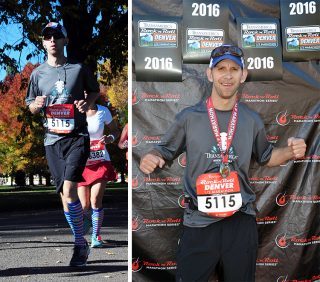
Michael Kutcher, the twin brother of actor Ashton Kutcher, is going to be the Transamerica Tomorrow Chaser in the Rock 'n' Roll Las Vegas Half Marathon on Nov. 13, starting last and raising money for every person he passes. Photos: MarathonFoto
So you think running a half marathon is a challenge?
Please!
Listen to the struggles that have been thrust upon Michael Kutcher, the twin brother of actor Ashton Kutcher. Born weighing less than five pounds, Michael was barely responsive at birth and struggled with his first breaths.
He faced developmental delays, then was diagnosed with cerebral palsy before kindergarten. At 13, Michael was diagnosed with heart failure and given less than a month to live. But he received a heart transplant and now, at 38, he’s a father, an assistant vice president for Transamerica, and yes, a runner.
On Nov. 13, Kutcher will start at the back of the pack of some 26,000 runners at the GEICO Rock ‘n’ Roll Las Vegas Half Marathon. With Transamerica emphasizing health management as well as wealth management, Transamerica will make a donation to the American Heart Association for every runner Kutcher passes.
It’s part of Transamerica’s Tomorrow Chaser program.
Asked where he derives his drive to face the obstacles strewn in his path, Kutcher said, “It goes back to what I learned at a very young age, from words my brother, Ashton, told me.
“He said, ‘You’re going to go through obstacles, challenges. Your life’s going to have ups and downs and sometimes it will be difficult. But you’re going to have people along your way to help you, guide you. At the end of the day, it’s our obstacle, your challenge to overcome.’
“So every time I encounter something, I try to grow from it and try to learn a lesson. Hopefully, it makes me a better person on the other end.”
About three months ago, Kutcher accepted the challenge of training for the Transamerica Rock ‘n’ Roll Denver Half Marathon.
“My running background was nothing,” Kutcher said. “Prior to this, I didn’t enjoy running at all. There really was no enjoyment in it.”
RELATED: The 2016 Rock ‘n’ Roll Las Vegas Half Marathon Finisher’s Medal Glows and Spins!
His first workout was not easy.
“I had to walk after the first few blocks,” he said.
But like Ashton told him there would be people to help him face life’s challenges, when he turned a corner near the end of that run, co-workers were waiting to escort him back to the office.
“Transamerica, it’s a team culture,” he said. “They showed me I’m really not in this on my own.”
He treated the half marathon like he did cerebral palsy and his heart transplant.
“I took it on as a challenge,” he said. “A chance to push my boundaries and show people that no matter what your challenges or your disability, your obstacles, you can do anything you want to do. That was instilled in me by my family at a very young age.”
Kutcher finished the Transamerica Rock ‘n’ Roll Denver Half Marathon in 3 hours, 46 seconds.
Running now, he said, is more fun.
“I went for an easy, four-mile jog the other night,” said Kutcher, who lives in Denver. “I’m finding the relaxation in it.”
He’s looking forward to Vegas, running on the Strip at Night, the pavement illuminated by the glare of the casinos. Family members plan to join him. Ashton and his wife, Mila Kunis, are awaiting the arrival of their second child and are expected to make a last-minute decision about joining Michael.
VIDEO: Time-Lapse Video of the Rock ‘n’ Roll Las Vegas Half Marathon Finish Line
As for living a life with a brother who’s recognized around the globe, Michael offered interesting thoughts on the subject.
“To be honest with you,” he said, “I view it no differently than having my sister. (His sister, Tausha, is three years older.)
“We are a close-knit family. Ashton has been in his career since he was 18, 19 years old. I’ve grown used to the exposure that comes with it. When I speak of him, I speak of him as my brother. I don’t recognize him in terms of the celebrity status that he has.
“I think he’s a great actor. I think he’s very gifted and skilled in that arena, but it’s hard for me to watch him on TV because I don’t view him as the character he plays. I view him with the mannerisms I grew up with, the voice I grew up with. I view him as my brother.”
Besides being blessed with grit, Michael carries some moxie, too.
“Without some of the exposure my last name brings, I wouldn’t have the opportunity to inspire others,” he said. “I try to take his notoriety, spin it and use it for a good cause.”
RELATED: Snoop Dogg Will Headline 2016 Rock ‘n’ Roll Las Vegas Races
The post Michael Kutcher Ready to Chase Tomorrow at GEICO Rock ‘n’ Roll Las Vegas Half Marathon appeared first on Competitor.com.
Shoe of The Week: Topo Athletic ST-2
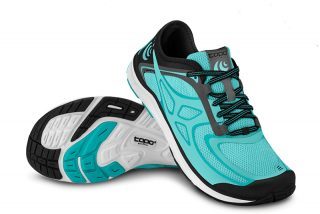
True to Topo Athletic’s core design philosophies, the ST-2 is built around natural running with room in the toe box for splay, a zero drop (or flat) and relatively low-profile 16m stack height (of which only 7mm is midsole material). The noteworthy comfort of the ST-2 comes from the plush 5mm footbed so that there is ample cushioning right up against the foot. The breathable, sock-like, stretchy mesh upper that both conforms and moves with your foot’s natural motion is also a source of creature comfort. The featherweight design (as light as most racing flats) gives it a “barely there” sensation, even though there is a copious amount of cush under foot.
The most salient quality of the ST-2 is the versatility that makes it an ideal travel shoe. The heel is collapsible, it’s super light, easy to pack and, at least with the black version, it can be worn on most any occasion without being considered gauche. The security of the upper also means that it serves well in gym or CrossFit settings. The price is right for such a multi-purpose shoe but know that for those lacking an efficient gait, it should be worn somewhat sparingly. The ST-2 is more minimalist and does not pretend to be a motion control or highly-cushioned, protective trainer.
This is the shoe for you if … you are traveling lightly and want the versatility of a single shoe that you can wear to run in, take to the gym or sport with casual business attire and go out for a nice dinner looking presentable while feeling comfortable and natural.
Price: $90
Weights: 6.8 oz. (men’s), 5.6 oz. (women’s)
Heel-Toe Offset: 0mm; 16mm (heel), 16mm (forefoot)
Info: topoathletic.com
RELATED: Shoe of the Week—New Balance Vazee Summit
The post Shoe of The Week: Topo Athletic ST-2 appeared first on Competitor.com.
November 8, 2016
How to Reduce Delayed Onset Muscle Soreness After a Big Race
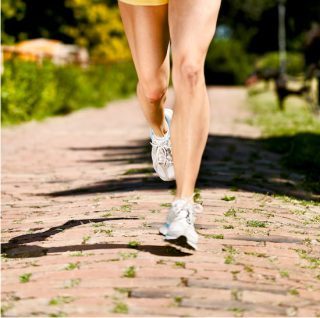
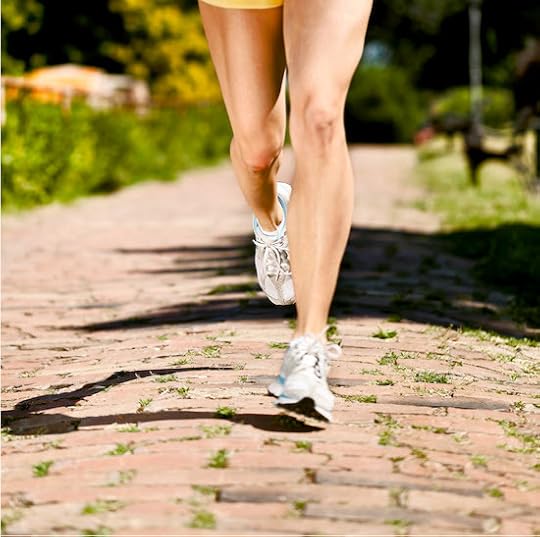
Training for a race can be exhausting and painful. When you put your body through intense workouts each day, it is going to respond with soreness and fatigue. This is true for both experienced and new runners.
Have you ever completed a long run and felt great all day, only to wake up the next morning stiff and sore? You are probably experiencing Delayed Onset Muscle Soreness (DOMS). DOMS is your body’s reaction to overexertion, and it causes tight, painful muscle movements that makes even the thought of exercise seem impossible.
Follow these tips to help reduce DOMS and stick to your routine!
Listen to Your Body
If you are going to demand an entire race (whether it’s a marathon, half marathon, 10K, or quick 2-mile jog) from your body, your body will make demands of its own.
Listen to your body. Don’t ignore pain, don’t ignore fatigue, and don’t ignore dehydration. If you do, your body won’t perform the way you want or need it to.
Warm Up
Take the time to warm up properly. Try to get a good dynamic stretch. Dynamic stretches stretch muscles by improving immediate range of motion—unlike static stretches (like the butterfly stretch) that prohibit immediate flexibility. Most dynamic stretches require a partner for assistance, as force needs to be applied.
If you want to achieve a dynamic stretch but don’t have a partner to offer assistance, try a stretching tool like the TheraBand Stretch Strap. Research shows that the Stretch Strap is as effective at increasing range of motion and improving flexibility as traditional partner stretching.
Warming topical analgesics are also great for warming up and preparing muscles for a long run. Topicals like Perform Atomic Heat are great for relieving any pain or soreness you may have, so you can exercise without the distraction.
Once you’re sure you’re warm, you can exercise comfortably knowing your muscles have received the proper attention they need.
Recovery
Typical recovery articles talk about using ice to reduce any swelling and inflammation you may have after a run.
Perform Cooling Gel is like the girlfriend ice brings to a family reunion that everyone ends up liking more than ice.
Just like ice, Perform works to cool the skin and reduce pain. But it does this without making you lug an ice bag around the house, and it lasts up to four hours. Apply to any painful area, and you can forget about the pain and focus on your training.
Feet feeling especially sore after a run? Try the Perform Foot Roller Kit, which includes Perform Pain Reliever and a TheraBand Foot Roller, to give your feet a cooling and relaxing massage. The best part? You can freeze the Foot Roller for an even greater cooling sensation.
Rest, Rest, Rest
Don’t burn yourself out by going to bed late, waking up at 4 a.m. and training your heart out every day. You need rest to encourage muscle recovery and allow your body to repair itself. And who doesn’t love sleep?!
Don’t underestimate the importance of proper warm up and recovery practices. If you don’t focus on what you do before and after exercise, you might not be able to enjoy your run. Follow these tips to make sure your next race is a success, and remember to listen to your body!
Rock, Roll, Run and WIN
Perform Pain Reliever wishes good luck to all GEICO Rock ‘n’ Roll Las Vegas participants as well as all those running a fall or winter marathon!
Remember: Pace yourself, have fun, PERFORM and recover!
If you plan to attend Rock ‘n’ Roll Las Vegas, stop by the Perform Pain Reliever expo booth #150 to meet our team and learn additional details about how you can win a FREE race entry and FREE Perform Pain Reliever products.
Here’s how to enter:
1. Like us on Facebook @PerformPainRelief
2. Post a picture of the race festivities to our page
You’ll be entered for a chance to win one of two prize packages, which include a year’s supply of Perform Pain Reliever and Atomic Heat and FREE entry into any 2017 Rock ‘n’ Roll Marathon race!
Best of luck in your running!
The post How to Reduce Delayed Onset Muscle Soreness After a Big Race appeared first on Competitor.com.
Experience the NYC Marathon Via a 360 VR Video

Want to get a first-hand look at the New York City Marathon course? CyberLink, the multimedia company behind the binge-watching Guinness World Record, teamed up with marathon runner Alex Christison and Sports Illustrated to create a 360 VR experience of Sunday’s New York City marathon. This 360 video, made with CyberLink’s PowerDirector 15, tracks Christison’s run from start to finish and simulates the first-person experience of running through New York’s five boroughs with some of the features of the course, cheering crowds and the spirit of camaraderie.
RELATED: Sara Hall’s FitBit Data from the NYC Marathon
The post Experience the NYC Marathon Via a 360 VR Video appeared first on Competitor.com.
November 7, 2016
Air Force Vet Treating Plantar Fasciitis One Pair of Flip Flops at a Time
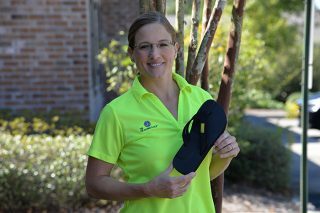
Air Force veteran Dr. Meredith Warner has used experience serving in Afghanistan to develop footwear aimed at healing plantar fasciitis.
During her time in the Air Force, Dr. Meredith Warner, an orthopedic surgeon, became frustrated with the gap in treatment for those suffering from plantar fasciitis, something she says is very common in the military.
According to Warner, total immobilization isn’t practical, injections and pain pills aren’t long-term solutions and she isn’t a fan of resorting to surgery for it. Physical therapy is her go-to modality, but it can prove cost prohibitive as soldiers transfer to civilian life. What she really wanted was a way for people to recover before becoming injured.
Now she’s putting her experience and expertise together in footwear products in an entrepreneurial venture called The Healing Sole.
“Plantar fasciitis pretty much affects everyone once you’re no longer a child,” says the 43-year old recreational runner who founded Warner Orthopedics and Wellness in Baton Rouge, La., in 2013. “The guys in infantry are carrying at least 80 pounds of battle rattle, like a flak vest, helmet, goggles and more, while they’re rucking, and they are doing so in footwear that isn’t necessarily awesome.”
RELATED: The Truth About Plantar Fasciitis
Warner saw soldiers being sent home because the severe pain from plantar fasciitis kept them from being able to do their job. And she saw others who wanted to do nothing but wear flip flops when whey weren’t wearing military boots, something their doctors advised them not to do. Towards the end of her deployment, she decided the best way to address the care gap was by turning one of the problems, flip flops, into the solution.
After retiring from the military, Warner earned her MBA from Louisiana State University, which is where she met Natalie Noel, who is now her business partner in The Healing Sole. So far, the company has been self-funded with Warner and Noel working more than six years from concept to delivery. They even did their own proof of concept study.
“Scientifically and in my head, I assumed the concept would work because it’s based on scientific principles and a lot of theories I use every day in treatment,” says Warner, who sees The Healing Sole as a way to impact more people and empower others to take care of pain, problems and recovery on their own. “You don’t’ really know until you know. The clinical trial proved to myself and the world that the design worked.”
Warner, a self-described “army brat” grew up playing soccer, averaging 8 miles of running per game. She also played for two years at the University of Delaware. Running became more of a focus once she was in the military.
“I was stationed at Bagram Air Base in Afghanistan, and they had a fence called ‘the perimeter.’ If you ran the whole thing if was 15 or 16 miles,” she says. “There was nothing to do except operate and workout, so we would run that a lot.”
RELATED: Team RWB Grows With Trail Running Camp for Veterans
Warner has since run a couple half marathons and is training for her first marathon, the Louisiana Marathon in Baton Rouge in January. She credits weight lifting and now yoga for keeping her injury-free.
The combination of her athleticism and medical training led to the unique design features in The Healing Sole Flip Flops ($124), which are directed at runners as the primary group of potential customers. A rockered bottom eliminates a lot of the need for muscle contraction and joint movement, allowing the foot to rest. Firm foam and a metatarsal bar provide structure, there’s a compression zone at the insertion point of the plantar fascia for a more normal heel strike and the ramp under the big toe keeps toes from “clawing” as they do in most flip flops.
Like most working moms, Warner, who has a daughter with another on the way, says it’s a “time crunch” between family, training, surgery and clinic hours. The transition from military to civilian life was a challenge as well.
“During my four years of active duty, if you wanted to go on a lunch run or leave early to workout, no one blinked because it’s part of the job,” Warner says. “But when you get in the private world, it’s totally different. It’s much harder to stay fit in a culture that doesn’t value it.”
Warner’s training incorporates quality over quantity, with at least one yoga session per week, weights and plenty of recovery time between hard run efforts.
“It’s important to me to stay strong, and not to ‘just’ run,” says Warner who promotes the same for her patients. “You can’t do just one thing because then you build up one group of muscles, and ultimately, that’s not the way the human body is designed.”
Strength, flexibility and recovery are so important to Warner that she’s in the process of building a new clinic including workout facilities and a yoga studio.
Warner, who jokes that work takes up about 90 percent of her time, says tackling Spain’s San Sebastian Trail is at the top of her “one day” bucket list. Until then, she’ll keep helping patients heal themselves, one pair of flip flips at a time.
The post Air Force Vet Treating Plantar Fasciitis One Pair of Flip Flops at a Time appeared first on Competitor.com.
Treating Plantar Fasciitis One Pair of Flip Flop at a Time

Army veteran Dr. Meredith Warner has used experience serving in Afghanistan to develop footwear aimed at healing plantar fasciitis.
During her time in the Air Force, Dr. Meredith Warner, an orthopedic surgeon, became frustrated with the gap in treatment for those suffering from plantar fasciitis, something she says is very common in the military.
According to Warner, total immobilization isn’t practical, injections and pain pills aren’t long-term solutions and she isn’t a fan of resorting to surgery for it. Physical therapy is her go-to modality, but it can prove cost prohibitive as soldiers transfer to civilian life. What she really wanted was a way for people to recover before becoming injured.
Now she’s putting her experience and expertise together in footwear products in an entrepreneurial venture called The Healing Sole.
“Plantar fasciitis pretty much affects everyone once you’re no longer a child,” says the 43-year old recreational runner who founded Warner Orthopedics and Wellness in Baton Rouge, La., in 2013. “The guys in infantry are carrying at least 80 pounds of battle rattle, like a flak vest, helmet, goggles and more, while they’re rucking, and they are doing so in footwear that isn’t necessarily awesome.”
RELATED: The Truth About Plantar Fasciitis
Warner saw soldiers being sent home because the severe pain from plantar fasciitis kept them from being able to do their job. And she saw others who wanted to do nothing but wear flip flops when whey weren’t wearing military boots, something their doctors advised them not to do. Towards the end of her deployment, she decided the best way to address the care gap was by turning one of the problems, flip flops, into the solution.
After retiring from the military, Warner earned her MBA from Louisiana State University, which is where she met Natalie Noel, who is now her business partner in The Healing Sole. So far, the company has been self-funded with Warner and Noel working more than six years from concept to delivery. They even did their own proof of concept study.
“Scientifically and in my head, I assumed the concept would work because it’s based on scientific principles and a lot of theories I use every day in treatment,” says Warner, who sees The Healing Sole as a way to impact more people and empower others to take care of pain, problems and recovery on their own. “You don’t’ really know until you know. The clinical trial proved to myself and the world that the design worked.”
Warner, a self-described “army brat” grew up playing soccer, averaging 8 miles of running per game. She also played for two years at the University of Delaware. Running became more of a focus once she was in the military.
“I was stationed at Bagram Air Base in Afghanistan, and they had a fence called ‘the perimeter.’ If you ran the whole thing if was 15 or 16 miles,” she says. “There was nothing to do except operate and workout, so we would run that a lot.”
Warner has since run a couple half marathons and is training for her first marathon, the Louisiana Marathon in Baton Rouge in January. She credits weight lifting and now yoga for keeping her injury-free.
The combination of her athleticism and medical training led to the unique design features in The Healing Sole Flip Flops, which counts runners as its main market. A rockered bottom eliminates a lot of the need for muscle contraction and joint movement, allowing the foot to rest. Firm foam and a metatarsal bar provide structure, there’s a compression zone at the insertion point of the plantar fascia for a more normal heel strike and the ramp under the big toe keeps toes from “clawing” as they do in most flip flops.
Like most working moms, Warner, who has a daughter with another on the way, says it’s a “time crunch” between family, training, surgery and clinic hours. The transition from military to civilian life was a challenge as well.
“During my four years of active duty, if you wanted to go on a lunch run or leave early to workout, no one blinked because it’s part of the job,” Warner says. “But when you get in the private world, it’s totally different. It’s much harder to stay fit in a culture that doesn’t value it.”
Warner’s training incorporates quality over quantity, with at least one yoga session per week, weights and plenty of recovery time between hard run efforts.
“It’s important to me to stay strong, and not to ‘just’ run,” says Warner who promotes the same for her patients. “You can’t do just one thing because then you build up one group of muscles, and ultimately, that’s not the way the human body is designed.”
Strength, flexibility and recovery are so important to Warner that she’s in the process of building a new clinic including workout facilities and a yoga studio.
Warner, who jokes that work takes up about 90 percent of her time, says tackling Spain’s San Sebastian Trail is at the top of her “one day” bucket list. Until then, she’ll keep helping patients heal themselves, one pair of flip flips at a time.
The post Treating Plantar Fasciitis One Pair of Flip Flop at a Time appeared first on Competitor.com.
Out There: Porta-Potty Etiquette for Runners
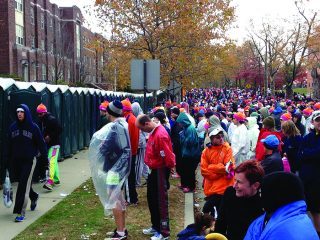
The New York City Marathon has one of the largest portable toilet mobilizations in the world with roughly 1,800 port-o-potties at the start of the race in 2015 and a few hundred more throughout the course. Photo: Courtesy of NYRR
You guys, we need to have a talk about what you’re doing in the bathroom.
Not about the technicalities—there are enough articles about how to poop before a race and how to not poop during a race. There’s plenty of handy resources about using your pee color to determine whether you’re dehydrated/how much water you should drink/who you should vote for in the next presidential election.
But no one—and I mean no one—is willing to talk to you about the havoc your bowels are wreaking on the Port-o-John. Great Scott, what are you doing in there?
If I walk into the bathroom at almost any civilized event venue, it’s clean and odor-free. I am all but guaranteed the soles of my shoes will not stick to the floor. I likely will not gag with disgust. At a pre-race portable toilet, not so much. There is pee on the seat. There is pee on the wall. There is a lake of pee on the floor. And that’s just pee—don’t even get me started on the colonic exorcisms that apparently take place in every stall.
RELATED: Out There: Pushing to the Finish
What the hell, runners?!
While doing research for a local magazine piece last month, my paths crossed with the owner of a porta-potty company (he prefers to refer to his work as “waste management,” and yes, he’s heard all the Tony Soprano jokes). After interviewing him about the story I was writing, the conversation shifted.
“You’re a runner?” he asked, pointing at my jacket, which was embroidered with the logo of my favorite race. I nodded—yes, I was a runner. Tony Soprano wrinkled his nose and shook his head:
“Oh, man. When it comes to this industry, runners are the worst.”
He then proceeded to tell me he got the majority of the portable toilet business for local races, because some of his competitors simply turned down the contracts because runners are the worst. For one, race directors tend to underestimate and under-budget for the number of facilities needed, leading to, er, capacity issues—their portos runneth over.
And then there’s the ick factor—cleaning out a potty used by hundreds of nervous runners (and their even more nervous bowels) takes more time and attention than the decontamination process after other events. Runners, it turns out, are gross. Matter that should not end up on the wall somehow ends up on the wall—and also the floor, the seat, the door and the ceiling.
“The ceiling?” I asked.
“The ceiling,” he replied, with a look that clearly conveyed You don’t want to know. The guy has seen some nasty shit. Literally.
This is not entirely new news to me. I’ve frequented many a port-o-potty along my training and racing, and I’m always floored by the sheer grossness of it all. But I had never really considered that runners were more disgusting users than, say, attendees at a music festival.
“Oh,” he lit up, “music festivals are great. I can clean up and turn around a unit from those in less than 5 minutes.”
Loos from running events, on the other hand, take more than ten minutes per toilet to clean. Not just because of the biological waste, but the other crap runners toss in there—every race yields at least one dumpster’s load of abandoned space blankets, dropped sunglasses and iPhones, improperly discarded feminine hygiene products, and wrappers from gels and bars. (Which begs yet another set of questions, the first of which is who is eating while they’re on the crapper?)
You hear that? Runners make more of a mess than drunk frat boys at a Kid Rock concert. We really are the worst.
We should be better. We must be better. Not just for our fellow runners, but for those who have to deal with the aftermath of our pre-race jitters. I have created a brief guide to help you navigate the tricky business of using the portable toilet. It is my humble attempt to preserve not only proper port-o-protocol, but also the dignity of those who are still in line, waiting for their turn.
Waste Management Protocol
I have to go to the bathroom.
You should have thought about that before you left the house, young padawan. Now go get in line for the port-o-john.
I missed my mark while using the toilet. What do I do now?
How? No, seriously, how? Do you not realize the receptacle is generously sized in comparison to the stream that flows forth from your body? Your target isn’t a teacup, nor is it a moving carnival game. Are you whizzing into a jet blade in hopes of distributing a fine mist of bodily fluid everywhere? Please take a searching moral inventory of yourself while you’re wiping down your mess for the next patron.
To hover or not to hover?
Squatting over a toilet actually delays your ability to go to the bathroom, which delays everyone waiting in line who really, really have to go. Besides, hover-peeing usually leads to pee on the seat, which leads to the next person hover-peeing, which leads to…you know how this goes, right? Only you can stop the cycle. Help us. You’re our only hope.
But…germs!
Studies show a person’s bottom and upper thighs, which are covered most of the day, are usually cleaner than their hands. The same hands you are apparently utilizing to eat that pre-race gel while you unload in the loo. Stop trying to pretend like you’re a delicate, pristine flower. Sit down and take a load off already. There are 5,000 other runners waiting in line.
Just in case, I put toilet paper on the seat before I sat down. Now I don’t want to touch it, because…germs.
You made your mess, now clean it up. (Quickly, please. I really need to use the restroom.)
What if I have to go Number Two?
Please, for the love of two-ply, just get it in the hole. Why is this such a hard concept to understand?
I don’t like the toilet paper used in the portable toilets.
I’m sure the feeling is mutual. Next time, bring your own.
What should I do with my trash?
Anything other than toilet paper should be placed in the proper trash receptacle located outside of the port-o-john.
What happens if I throw my trash into the toilet?
It would make for some very bad race karma. You know those pictures of runners crapping themselves on the course? Probably that.
I dropped my iPhone. Nobody go in there until we fish it out!
Are you freaking kidding me? Move aside, I can’t hold it any longer.
***
About the Author
Susan Lacke does 5Ks, Ironman Triathlons and everything in between to justify her love for cupcakes (yes, she eats that many). She lives and trains in Salt Lake City, Utah with three animals: a labrador, a cattle dog, and a freakishly tall triathlete husband. Lacke claims to be of sound mind, though this has yet to be substantiated by a medical expert. Follow her on Twitter: @SusanLacke
The post Out There: Porta-Potty Etiquette for Runners appeared first on Competitor.com.
Ryan Hall's Blog
- Ryan Hall's profile
- 21 followers



